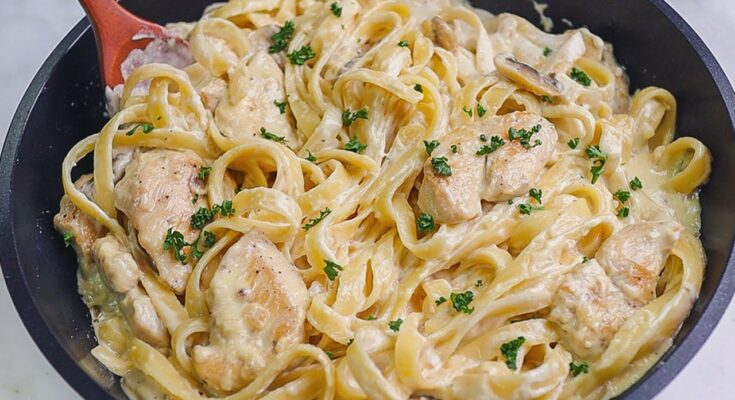Alfredo Recipe: Alfredo sauce is the ultimate comfort food. Creamy, rich, and bursting with flavor, it’s no wonder this classic Italian-American dish is a favorite around the world. Originating in early 20th-century Rome, Alfredo sauce was initially a simple blend of butter and Parmesan cheese.
Over time, the recipe evolved into the creamy delight we know today, made with heavy cream, garlic, and rich Parmesan. Whether you’re hosting a dinner party or whipping up a quick weeknight meal, Alfredo is a go-to recipe everyone should master.
Ingredients for Alfredo Sauce
Here’s what you’ll need to create this timeless dish:
Essential Ingredients:
- 2 cups of heavy cream
- 1/2 cup unsalted butter
- 2 cups freshly grated Parmesan cheese
- 3-4 cloves of garlic, minced
- Salt and freshly ground black pepper to taste
Optional Additions:
- A pinch of nutmeg for depth
- Chopped parsley for garnish
- Red pepper flakes for a kick of spice
These ingredients combine to create a velvety sauce with just the right amount of flavor. Always use fresh Parmesan and high-quality cream for the best results.
Essential Tools and Equipment
To make Alfredo sauce seamlessly, ensure you have the following kitchen tools:
- A large skillet or sauté pan for the sauce.
- A medium saucepan for boiling pasta.
- A whisk to blend the sauce ingredients smoothly.
- Measuring cups and spoons to get the proportions right.
- A spatula for stirring.
Pro tip: Use a non-stick skillet to prevent sticking and burning, which is especially important when working with dairy-based sauces.
Step-by-Step Preparation Guide
Step 1: Preparing the Ingredients
Before you begin cooking, take a few moments to prepare your ingredients.
- Measure the ingredients accurately to ensure a balanced sauce.
- Mince the garlic finely for even distribution throughout the sauce.
- Grate the Parmesan cheese fresh; pre-grated cheese often has anti-caking agents that can affect the texture of the sauce.
- Bring your butter and cream to room temperature to help them blend more easily.
These small steps lay the foundation for a flawless Alfredo sauce.
Step 2: Making the Alfredo Sauce
Making Alfredo sauce requires careful attention to detail but is relatively straightforward:
- Melt the butter: In a large skillet, melt the butter over medium heat. Add the minced garlic and sauté for about 1 minute until fragrant.
- Add the cream: Slowly pour in the heavy cream while whisking continuously to combine.
- Simmer and season: Reduce the heat to low and let the mixture simmer gently for 5 minutes. Season with salt, pepper, and a hint of nutmeg if desired.
- Incorporate the cheese: Gradually stir in the Parmesan cheese, a little at a time, ensuring it melts completely before adding more. This creates a silky, lump-free sauce.
The key to perfect Alfredo sauce is patience—low heat and constant stirring prevent the cream from curdling and ensure a smooth consistency.
Step 3: Cooking the Pasta
While the sauce simmers, it’s time to cook your pasta.
- Choose classic options like fettuccine, but penne or linguine work just as well.
- Bring a large pot of salted water to a boil. The salt enhances the pasta’s flavor.
- Add the pasta and cook until al dente, as the pasta will continue to soften slightly when mixed with the sauce.
Reserve about a cup of the starchy pasta water before draining. This water can help adjust the sauce’s thickness later.
Step 4: Combining Pasta and Sauce
Now for the fun part—bringing everything together.
- Mix it up: Transfer the cooked pasta into the skillet with the Alfredo sauce.
- Toss and coat: Use tongs to toss the pasta gently, ensuring each strand is thoroughly coated with the sauce.
- Adjust the texture: If the sauce seems too thick, add a splash of the reserved pasta water and stir until it reaches your desired consistency.
This step is where the magic happens, as the creamy sauce clings to the pasta for that luxurious finish.
Step 5: Serving Alfredo Pasta
Presentation is the cherry on top of a great dish.
- Serve the Alfredo pasta in warm bowls or plates to keep it hot longer.
- Garnish with chopped parsley for a pop of color and freshly grated Parmesan for extra flavor.
- Pair with garlic bread or a crisp green salad for a complete meal.
Your Alfredo pasta is now ready to delight taste buds!
Customizing Your Alfredo
Alfredo pasta is versatile and can be adapted to suit a variety of tastes and dietary preferences. Here’s how you can take your Alfredo game to the next level:
Adding Proteins
- Chicken: Grilled or sautéed chicken breast is a classic addition. Slice it into strips and place it on top of the pasta or mix it in.
- Shrimp: Pan-seared shrimp adds a rich, briny flavor. Cook shrimp with garlic and butter for a cohesive taste profile.
- Mushrooms: Sautéed mushrooms provide an earthy depth to the dish, making it perfect for vegetarians.
Vegetarian Substitutions
- Broccoli florets or spinach can be stirred into the sauce for added nutrients.
- Use tofu or plant-based protein for a meat-free alternative that still feels hearty.
Creative Twists
- Add a handful of sundried tomatoes for tanginess.
- Incorporate fresh basil or thyme for an herbal note.
These customizations not only elevate the dish but also make it your own.
Common Mistakes to Avoid
Even simple recipes like Alfredo can go wrong if you’re not careful. Avoid these pitfalls:
- Overheating the sauce: High heat can cause the cream to separate. Always simmer on low heat.
- Using pre-shredded cheese: It doesn’t melt as smoothly due to additives. Opt for freshly grated Parmesan.
- Overcooking pasta: Alfredo pasta tastes best when the pasta is al dente. Overcooked pasta can become mushy and won’t hold the sauce well.
- Skipping the whisk: Whisking ensures a smooth, creamy texture. Skipping this step can result in lumps.
By sidestepping these mistakes, you’ll achieve restaurant-quality Alfredo every time.
Healthier Alfredo Alternatives
Craving Alfredo but looking to keep it lighter? Here are some healthier versions to try:
Low-Fat Alfredo
- Replace heavy cream with low-fat milk or Greek yogurt.
- Use less butter and opt for olive oil instead.
- Choose a reduced-fat Parmesan cheese.
Vegan Alfredo
- Use cashews soaked in water and blended until smooth as the base.
- Substitute nutritional yeast for Parmesan for a cheesy flavor.
- Replace butter with plant-based margarine or coconut oil.
Alternative Pastas
- Zucchini noodles or spaghetti squash can be used for a low-carb option.
- Whole-grain or gluten-free pasta works well for specific dietary needs.
These tweaks allow you to enjoy Alfredo without the guilt!
Serving Suggestions
Alfredo pasta pairs beautifully with a variety of side dishes and beverages. Here are some ideas:
- Garlic Bread: The buttery, garlicky flavors complement the richness of the sauce.
- Salads: A crisp Caesar or arugula salad provides a refreshing contrast.
- Vegetables: Roasted asparagus, Brussels sprouts, or green beans add a fresh touch.
- Beverages: Serve with a glass of chilled white wine like Chardonnay or a sparkling water infused with lemon.
A well-rounded meal enhances the Alfredo experience.
Storage and Reheating Tips
Alfredo sauce is best enjoyed fresh, but leftovers can be stored and reheated carefully.
Storing
- Transfer leftovers to an airtight container and refrigerate for up to 3 days.
- Avoid freezing as the cream-based sauce can separate upon thawing.
Reheating
- Place the pasta in a skillet over low heat and add a splash of milk or cream to revive the sauce.
- Stir constantly to prevent separation and ensure even heating.
Reheated Alfredo can be just as delicious if done right!
FAQs About Alfredo Recipe
Alfredo sauce is a classic favorite for pasta lovers worldwide. Below are some commonly asked questions about making, serving, and storing Alfredo recipes:
What are the main ingredients in Alfredo sauce?
Traditional Alfredo sauce includes butter, heavy cream, Parmesan cheese, garlic, and a pinch of salt and pepper for flavor. Some recipes may add cream cheese or milk for extra creaminess.
Can I make Alfredo sauce without heavy cream?
Yes, you can substitute heavy cream with whole milk, half-and-half, or even non-dairy alternatives like coconut cream or cashew milk for a lighter option.
How do I prevent Alfredo sauce from separating?
To avoid curdling, use low heat while cooking and whisk continuously. Adding cheese gradually helps maintain a smooth consistency.
What type of pasta works best with Alfredo sauce?
Fettuccine is the traditional choice, but Alfredo pairs wonderfully with penne, linguine, or even spiral pasta.
Can I store leftover Alfredo sauce?
Yes, store it in an airtight container in the refrigerator for up to 3 days. Reheat gently on low heat, adding a splash of milk or cream to restore its creamy texture.
How can I enhance the flavor of Alfredo sauce?
Add herbs like parsley or thyme, or include proteins like grilled chicken, shrimp, or sautéed mushrooms for a rich and flavorful meal.
Conclusion
Making Alfredo pasta from scratch is a rewarding experience that combines simplicity and elegance. Whether you stick to the classic recipe or customize it with your favorite ingredients, the creamy texture and savory flavors are bound to impress. Don’t be afraid to experiment and make this dish your own—it’s a timeless comfort food that deserves a spot in your culinary repertoire.



